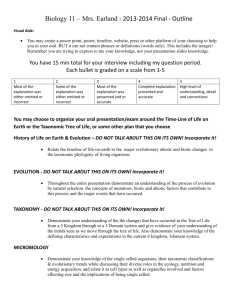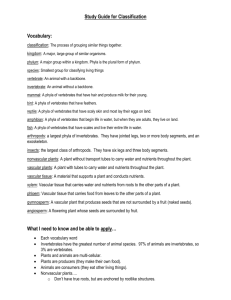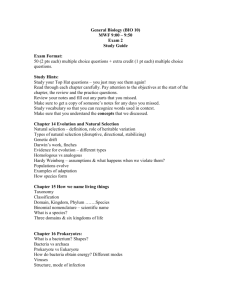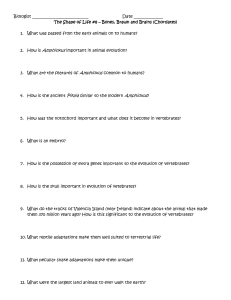Final
advertisement
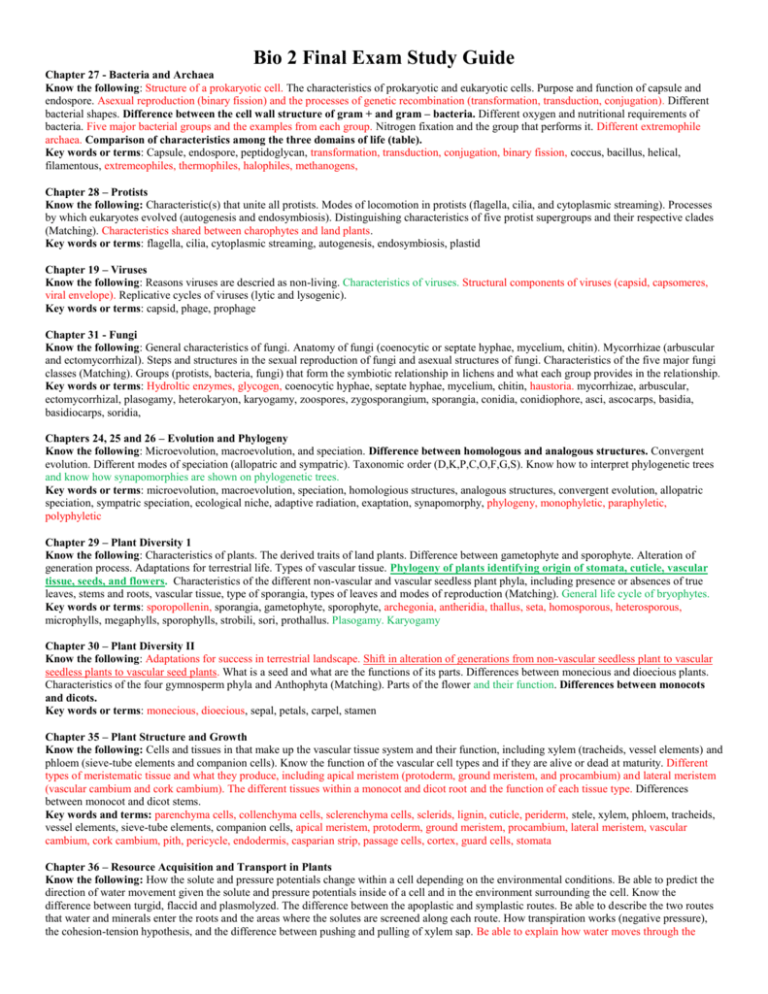
Bio 2 Final Exam Study Guide Chapter 27 - Bacteria and Archaea Know the following: Structure of a prokaryotic cell. The characteristics of prokaryotic and eukaryotic cells. Purpose and function of capsule and endospore. Asexual reproduction (binary fission) and the processes of genetic recombination (transformation, transduction, conjugation). Different bacterial shapes. Difference between the cell wall structure of gram + and gram – bacteria. Different oxygen and nutritional requirements of bacteria. Five major bacterial groups and the examples from each group. Nitrogen fixation and the group that performs it. Different extremophile archaea. Comparison of characteristics among the three domains of life (table). Key words or terms: Capsule, endospore, peptidoglycan, transformation, transduction, conjugation, binary fission, coccus, bacillus, helical, filamentous, extremeophiles, thermophiles, halophiles, methanogens, Chapter 28 – Protists Know the following: Characteristic(s) that unite all protists. Modes of locomotion in protists (flagella, cilia, and cytoplasmic streaming). Processes by which eukaryotes evolved (autogenesis and endosymbiosis). Distinguishing characteristics of five protist supergroups and their respective clades (Matching). Characteristics shared between charophytes and land plants. Key words or terms: flagella, cilia, cytoplasmic streaming, autogenesis, endosymbiosis, plastid Chapter 19 – Viruses Know the following: Reasons viruses are descried as non-living. Characteristics of viruses. Structural components of viruses (capsid, capsomeres, viral envelope). Replicative cycles of viruses (lytic and lysogenic). Key words or terms: capsid, phage, prophage Chapter 31 - Fungi Know the following: General characteristics of fungi. Anatomy of fungi (coenocytic or septate hyphae, mycelium, chitin). Mycorrhizae (arbuscular and ectomycorrhizal). Steps and structures in the sexual reproduction of fungi and asexual structures of fungi. Characteristics of the five major fungi classes (Matching). Groups (protists, bacteria, fungi) that form the symbiotic relationship in lichens and what each group provides in the relationship. Key words or terms: Hydroltic enzymes, glycogen, coenocytic hyphae, septate hyphae, mycelium, chitin, haustoria. mycorrhizae, arbuscular, ectomycorrhizal, plasogamy, heterokaryon, karyogamy, zoospores, zygosporangium, sporangia, conidia, conidiophore, asci, ascocarps, basidia, basidiocarps, soridia, Chapters 24, 25 and 26 – Evolution and Phylogeny Know the following: Microevolution, macroevolution, and speciation. Difference between homologous and analogous structures. Convergent evolution. Different modes of speciation (allopatric and sympatric). Taxonomic order (D,K,P,C,O,F,G,S). Know how to interpret phylogenetic trees and know how synapomorphies are shown on phylogenetic trees. Key words or terms: microevolution, macroevolution, speciation, homologious structures, analogous structures, convergent evolution, allopatric speciation, sympatric speciation, ecological niche, adaptive radiation, exaptation, synapomorphy, phylogeny, monophyletic, paraphyletic, polyphyletic Chapter 29 – Plant Diversity 1 Know the following: Characteristics of plants. The derived traits of land plants. Difference between gametophyte and sporophyte. Alteration of generation process. Adaptations for terrestrial life. Types of vascular tissue. Phylogeny of plants identifying origin of stomata, cuticle, vascular tissue, seeds, and flowers. Characteristics of the different non-vascular and vascular seedless plant phyla, including presence or absences of true leaves, stems and roots, vascular tissue, type of sporangia, types of leaves and modes of reproduction (Matching). General life cycle of bryophytes. Key words or terms: sporopollenin, sporangia, gametophyte, sporophyte, archegonia, antheridia, thallus, seta, homosporous, heterosporous, microphylls, megaphylls, sporophylls, strobili, sori, prothallus. Plasogamy. Karyogamy Chapter 30 – Plant Diversity II Know the following: Adaptations for success in terrestrial landscape. Shift in alteration of generations from non-vascular seedless plant to vascular seedless plants to vascular seed plants. What is a seed and what are the functions of its parts. Differences between monecious and dioecious plants. Characteristics of the four gymnosperm phyla and Anthophyta (Matching). Parts of the flower and their function. Differences between monocots and dicots. Key words or terms: monecious, dioecious, sepal, petals, carpel, stamen Chapter 35 – Plant Structure and Growth Know the following: Cells and tissues in that make up the vascular tissue system and their function, including xylem (tracheids, vessel elements) and phloem (sieve-tube elements and companion cells). Know the function of the vascular cell types and if they are alive or dead at maturity. Different types of meristematic tissue and what they produce, including apical meristem (protoderm, ground meristem, and procambium) and lateral meristem (vascular cambium and cork cambium). The different tissues within a monocot and dicot root and the function of each tissue type. Differences between monocot and dicot stems. Key words and terms: parenchyma cells, collenchyma cells, sclerenchyma cells, sclerids, lignin, cuticle, periderm, stele, xylem, phloem, tracheids, vessel elements, sieve-tube elements, companion cells, apical meristem, protoderm, ground meristem, procambium, lateral meristem, vascular cambium, cork cambium, pith, pericycle, endodermis, casparian strip, passage cells, cortex, guard cells, stomata Chapter 36 – Resource Acquisition and Transport in Plants Know the following: How the solute and pressure potentials change within a cell depending on the environmental conditions. Be able to predict the direction of water movement given the solute and pressure potentials inside of a cell and in the environment surrounding the cell. Know the difference between turgid, flaccid and plasmolyzed. The difference between the apoplastic and symplastic routes. Be able to describe the two routes that water and minerals enter the roots and the areas where the solutes are screened along each route. How transpiration works (negative pressure), the cohesion-tension hypothesis, and the difference between pushing and pulling of xylem sap. Be able to explain how water moves through the xylem in the stem into the leaf and then through the leaf into the atmosphere. The definition of bulk. Things that stimulate stomatal opening and closing. Adaptations for reduced transpiration. Areas that typically act as sugar sources and sinks. Key words and terms: tonicity, hypertonic, isotonic, hypotonic, turgid, flaccid, plasmolyzed, apoplastic, symplastic, casparian strip, suberin, transpiration, cohesion-tension hypothesis, guttation, bulk flow, translocation, sugar source, sugar sink, circadian rhythm Chapter 39 – Response to Signals in Plants Know the following: The five major hormones in plants (auxin, cytokinins, gibberellins, abscisic acid, and ethylene), and the major functions. Different types of movement in plants and what drives gravitropism (statoliths). Plant response to environmental stress (drought, oxygen deprivation, salt, heat, cold) and herbivory (signal predators, produce chemicals, alter flowering). Know the two types of plant responses to pathogens (hypersensitive, and systemic-acquired) and how they differ. Key words and terms: tropism, phototropism, gravitropism, statoliths, thigmotropism, senescence, photoperiodism, heat-shock proteins, antifreeze proteins, Pathogen-associated molecular patterns (PAMPs), hypersensitive response, systemic acquired response Chapter 37 – Soil and Plant Nutrition Know the following: How soils attract positively charged molecules (cation exchange). What is an essential element? Know the macronutrients and micronutrients. Purpose of nitrogen fixation. Ways that plants absorb or obtain nitrogen. Different types of mycorrhizae. Unique adaptations in plants Key words and terms: cation, anion, nodules, ectomycorrhizae, arbuscular mycorrhizae, arbuscules, epiphytes, haustoria Chapter 32: Animal Diversity and Physiology Know the following: Characteristics of animals. Know the differences between Protostomes and Deuterostomes (cleavage, coelom formation, and fate of blastopore). Differences between acoelomates, pseudocoelomates and coelomates. Different types of skeletons and which phyla have each type of skeleton. Know which phyla are segmented. Know the different circulatory systems and which phyla have each type of system. Compare and contrast the open and closed circulatory system. Know the different digestive systems and which phyla have each type of system. Know the different thermoregulatory strategies and which animals use each type of strategy. The different types of heat exchange with the environment. The different adaptations for thermoregulation. Modes of energy conservation. Be able to explain how counter-current heat exchange works. Different feeding modes. What is an essential nutrient? Know how much energy is produced by each macronutrient. Key words or terms: Gastrulation, blastopore, blastocoel, gastrula, metamorphosis, larva, endoderm, mesoderm, ectoderm, diploblastic, triploblastic, acoelomates, pseudocoelomates, coelomates, hemolymph, endotherm, ectotherm, poikilotherm, homeotherm, torpor, estivation, hibernation Chapter 33: Invertebrates 1 Know the following: Know the general characteristics of all invertebrate phyla (organization, symmetry, tissue layers, circulatory system, and digestive system) (Matching). The different classes Cnidaria and the dominant life stages (polyp and medusa) found in each class. What are protonephridia? Know the characteristics of molluscs and the characteristics of each class of molluscs (Matching). Key words or terms: Choanocytes, asconoid, syconoid, leuconoid, cnidocytes, nematocysts, polyp, medusa, protonephridia, radula Chapter 33: Invertebrates II Know the following: Know the general characteristics of all invertebrate phyla (organization, symmetry, tissue layers, circulatory system, and digestive system) (Matching). What animals have metanepheridia? What phyla are considered ecdysozoans? Know the characteristics of the Arthropod and the subphylums, classes, and groups of Arthropods. Know the function of Malpighian tubules. Know the different modes of respiration in Arthropods (book lungs and tracheal system). Key words or terms: Parapodia, chaetae, peristalsis, metanepheriduium, metamorphosis Chapter 33, 34, and 42: Deuterostomes and Circulation Know the following: Characteristics of echinoderms. Pathway of water through the water vascular system of echinoderms. Characteristics of Chordata. Characteristics of Vertebrates. Know the key adaptations in vertebrate evolution and how they changed the course of vertebrate evolution. Also know where these adaptations arose during the course of vertebrate evolution (Be able to write in the adaptations on a phylogeny). Know the heart anatomy and circulatory system of the different vertebrate groups (number of chambers, circuits). Know the path of blood through the heart and body (pulmonary and systemic circuits). Phases of the cardiac cycle (diastolic and systolic). Differences between arteries, capillaries and veins. Different components of blood and their function. Be able to describe how your breathing is controlled and why you breathe into a paper bag when hyperventilating (too much oxygen). Key words or terms, diastole, systole, erythrocytes, leukocytes, platelets, hemoglobin, plasma Chapters 40 and 49: Animal Structure and Muscle Function Know the following: The function of the different types of animal tissues. Know the location and function of the different epithelial tissues. Know the location (when provided) and function of the different connective tissues. Know the types of cells that form muscles, bone, and cartilage. Know the differences between the different types of muscles (voluntary/involuntary, sarcomeres/no sarcomeres, intercalated disks). Be able to describe how a muscle contracts including the role of calcium ions, tropomyosin, and the troponin complex. Key words or terms: simple, stratified, pseudostratified, cuboidal, columnar, squamous, fibroblasts, osteoblasts, chondrocytes, myofibrils, sarcomeres, actin, myosin, tropomyosin, troponin complex, oxidative, glycolytic Chapter 34: Diversity of fishes Know the following: Modes of reproduction in fish. Know which vertebrates have pronephros, mesonephros,and metanephros. Characteristics of fish in superclass Agnatha, class Chondrichthyes, class Sarcopterygii, class Actinopterygii, and the superorders within Teleosti. (Matching) Key words or terms: Oviparous. Ovoviviparous. Viviparous. Osmocoformer. Osmoregulator. Anadromous. Ascending process. Pharyngeal dentition. Photophores. Webarian apparatus. Physostomes. Leptocephalus larvae. Rostral organ. Swim bladder. Lateral line. Ampullae de Lorenzini. Placoid and Ctenoid scales. Chapter 34: Origin of Tetrapods, Amphibians and Reptiles. Know the following: What adaptations facilitated evolution of tetrapods and their movement onto land? Characteristics of amphibians and the differences among the three amphibian orders (Matching). Function of the different parts of the amniotic egg. Know which vertebrates have an anapsid, synapsid and diapsid skull. Know the characteristics of the different reptiles orders (classes?) (Matching). Know the difference between snakes and lizards. Know the function of the sensory adaptations found in snakes. Know the difference between and poisonous animal and a venomous animal and the effects of the two different types of toxins. Know the ways that you can tell and crocodile and an alligator apart. Key words and terms: Eusthenopteron. Acanthostega. Ichtheyostega. Limnoscelis. Tiktaalik. Cryptodira. Plurodira. Autotomy. Viparidae. Elapsidae. Colubridae Chapter 43: Immune System Know the following: Differences between a pathogen, antigen, epitope and antibody. Two types of immune response and what organisms have each type of immune response. Cells involved in the innate immune response, including the types of phagocytes and their function. Steps involved in an inflammatory response, including the different cell types and their functions. Two types of immunity involved in the adaptive immune response (cell-mediated and humoral immunity) and where B and T-cells mature. Two types of B-cells and their function. Function of antibodies. Key words or terms: Pathogen. Antigen. Epitope. Antibody. Phagocytes. Neutrophils. Macrophages. Dendritic cells. Eosinophils. Mast cells. Histamine. Interferons. Compliment proteins. Neutral killer cells. Cytokines. Chemokines. Apoptosis. Antigen-presenting cells. Perforin. Granzymes. Chapters 48, 49 and 50: Nervous System Know the following: Difference between central and peripheral nervous system, afferent and efferent divisions, the somatic and autonomic nervous system, and the parasympathetic and sympathetic divisions. Know the different responses of the parasympathetic and sympathetic divisions of the autonomic nervous system. Parts of a neuron and their function. What is the membrane potential and how is it maintained? Role of the sodium potassium pump. Know how an action potential is transmitted, including the stages of an action potential, the gated ion channels involved and when they are open or closed, the depolarization of the neuron, and the ions involved in the depolarization. What is the function of the myelin sheath? What happens at the Nodes of Ranvier? Be able to explain how a signal passed between neurons, including the function of neurotransmitters and the ligand gated channels. Function of inhibitory and excitatory neurotransmitters. Different regions of the brain and their function. Types of sensory receptors and the senses that use each type of receptor. Differences between tonic and phasic receptors. Be able to explain how your ear converts a sound wave to an electrical signal. Know the parts of the inner ear, including the vestibular and tympanic canals and the tectorial membrane, and the type of receptors involved. Parts of the eye and their function. Types of photoreceptors and their function. Key words and terms: Dendrites. Axon. Synaptic terminals. Schwann cells. Oligodendrocytes. Nerve. Ganglion. Nodes of Ranvier. Membrane potential. Gated ion channels. Depolarization. Action potential. Axon hillcock. Refractory period. Synapse. Synaptic cleft. Neurotransmitter. Ligandgated ion channel. Forebrain. Midbrain. Hindbrain. Cerebrum. Cerebellum. Corpus callosum. Dicephalon. Thalamus. Hypothalamus. Pituitary gland. Pons. Medulla oblongata. Motor cortex. Thermoreceptors. Mechanoreceptors. Chemoreceptors. Photoreceptors. Electromagnetic receptors. Tympanic membrane. Malleus. Incus. Stapes. Oval window. Cochlea. Vestibular and Tympanic canals. Tectorial membrane. Pupil. Lens. Iris. Ciliary body. Retina. Chapter 34: Birds Know the following: Characteristics of birds. Key adaptations for flight. Differences between reptiles, birds and mammals including the jaw bones, ear bones, heart, red blood cells, thermoregulation and reproduction (Table). Different between pennaceous and plumulaceous feathers and the feathers characterized as each type of feather. Function of feathers. Different types of plumage coloration. Anatomy of birds and the fusion of the different bones. Muscles used in upstroke and downstroke in flight. Sequence of respiration in birds. Thermoregulatory strategies in birds. Advantages and disadvantages of flocking. Ways that males attract mates. Different breeding systems in birds. Different types of bird development. Two major groups of birds and their characteristics. Key words and terms: Calamus. Rachis. Barbs and barbules. Vane. Pennaceous. Plumaceous. Contour feathers. Semiplume. Filoplume. Bristle. Downy. Monogamy. Polygamy. Polygyny. Polyandry. Polygynandry. Brood parasitism. Altericial. Precocial. Palaeognathae. Neognathae Chapter 34: Mammals Know the following: Synapomorphies of mammals. Advances during the evolution of mammals and when the first appeared, including the limb orientation, palate, lower jaw bone, placement of articular and quadrate, and dentition. Different tooth types and their function. Difference between digestive tracts in carnivores and herbivores. Different modes of locomotion. Different times of activity. Differences between monotremes, marsupials and eutherians, including body temperature, mode of nourishment (egg, yolk-sac placenta, or placenta), presence of nipples, number of vagina and uteri, neocortex development and presence of a corpus callosum. Different orders and groups (Mysticeti and Odonticeti) of mammals and their distinguishing characteristics. Key words or terms: Plantigrade. Digitigrade. Unguligrade. Diunral. Crepuscular. Nocturnal. Prolactin. Oxytocin. Cloaca. Baculum. Neocortex. Corpus callosum. Chapters 34, 41 and 44: Human Evolution, Excretion and Digestion Know the following: Characteristics of Homo sapiens. When homo sapien characteristics first appeared in the different hominin lineages. Two theories for origin of modern human races. Parts of the nephron and their function. Location where most reabsorption takes place. Be able to describe the process of reabsorption through the nephron including the major parts of the nephron, what is being filtered out at each section of the nephron, and if molecules are filtered by active or passive transport. Locations where the osmolarity of the filtrate is greatest. Accessory glands of the digestive system and what they produce. Initial and primary sites of digestion of carbohydrates, lipids, and protein. Function of the epiglottis. Be able to describe how stomach acid and pepsin are produced without destroying the cells and tissue that produce them. What carries carbohydrates, lipids, and proteins away from the small intestine and where does it go? Be able to describe the process of emulsification of lipids. Key words and terms: Hominins, Paranthropus, Australopithecus, Sahelanthropus, Homo erectus, Homo ergaster, Homo neanderthalensis, Homo sapiens. Metanephros. Glomerulus. Proximal tubule. Loop of Henle, Distal tubule. Pepsinogen. Pepsin. Chyme. Hepatic portal vein. Bile salts. Lipase. Monoglycerides. Fatty acids. Triglycerides. Chylomicron. Chapter 25: History of Life and Biogeography Know the following: Six mass extinction events and the % of families and animals impacted by each event. Difference between vicariance and dispersal. Major events of the four eras Key words and terms: Paleozoic, Mesozoic, Cenozoic, and Precambrian Desert Field Trip Know the following: Definition of a desert. What causes evaporation? Three different ways a desert can form and the cause of our local deserts. Know the names of the four North American deserts and whether they are a hot or cold desert. Know which plants are found in the Mojave Desert and which ones are found in the Sonoran Desert. Relatives of hyenas. Fastest land animal in North America and the reason for its speed. Estuary and Intertidal Field Trip Know the following: Different habitats within an estuary and the types of plants and animals found in each habitat. Know which habitat has the greatest number of organisms. What percentage of wetlands have disappeared in southern California? Why is an estuary like an egg beater? Sponge? Hotel? Strainer? Difference between spring and neap tides. Know the different intertidal zones and the species that can be found in each zone. Know the challenges to life in the intertidal zone and the adaptations that organisms have to cope with these challenges. Know all the phyla that we saw in the intertidal zone. Key words or terms: Estuary, desiccation
